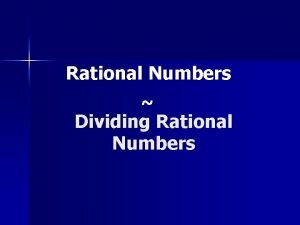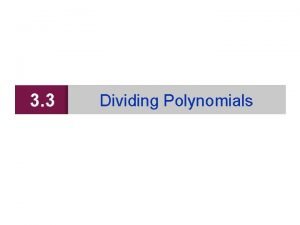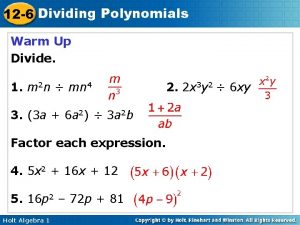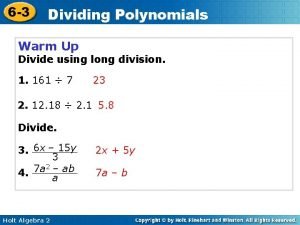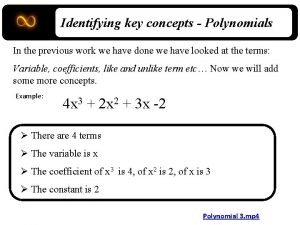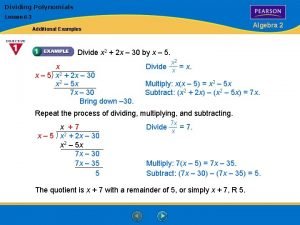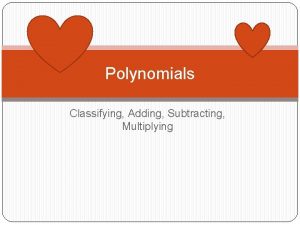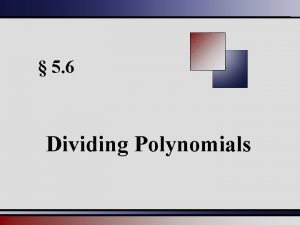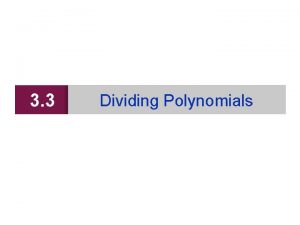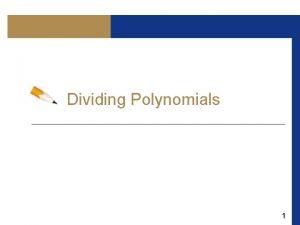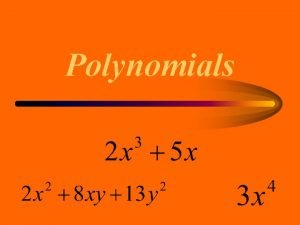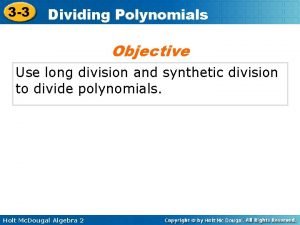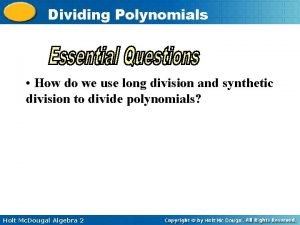Dividing Polynomials Long division of polynomials is similar



















- Slides: 19

Dividing Polynomials Long division of polynomials is similar to long division of whole numbers. When you divide two polynomials you can check the answer using the following: dividend = (quotient • divisor) + remainder The result is written in the form: quotient + Copyright © by Houghton Mifflin Company, Inc. All rights reserved. 1

Long Division

Example: Divide x 2 + 3 x – 2 by x – 1 and check the answer. x + 2 1. 2. x 2 + x 3. 2 x – 2 2 x + 2 4. – 4 5. remainder Answer: x + 2 + Check: (x + 2) 6. – 4 (x + 1) + (– 4) = x 2 + 3 x – 2 quotient divisor remainder Copyright © by Houghton Mifflin Company, Inc. All rights reserved. 3 dividend correct

Example: Divide 4 x + 2 x 3 – 1 by 2 x – 2 and check the answer. x 2 + x + 3 Write the terms of the dividend in descending order. 2 x 3 – 2 x 2 Since there is no x 2 term in the dividend, add 0 x 2 as a placeholder. + 4 x 2 x 2 – 2 x 1. 6 x – 1 3. 6 x – 6 5 Answer: x 2 +x+3 4. 5 6. 7. Check: (x 2 + x + 3)(2 x – 2) + 5 = 4 x + 2 x 3 – 1 Copyright © by Houghton Mifflin Company, Inc. All rights reserved. 2. 9. 4 8.

Example: Divide x 2 – 5 x + 6 by x – 2. x – 3 x 2 – 2 x – 3 x + 6 0 Answer: x – 3 with no remainder. Check: (x – 2)(x – 3) = x 2 – 5 x + 6 Copyright © by Houghton Mifflin Company, Inc. All rights reserved. 5



Synthetic Division Use synthetic division to find (x 3 – 4 x 2 + 6 x – 4) ÷ (x – 2). Step 1 Write the terms of the x 3 – 4 x 2 + 6 x – 4 dividend so that the degrees of the terms are in – 6 descending order. Then write 1 – 4 4 just the coefficients as shown. Step 2 Write the constant r of 1 – 4 6 the divisor x – r to the – 4 left. In this case, r = 2. 1 Bring the first coefficient, 1, down as shown.

Synthetic Division Step 3 Multiply the first coefficient by r : 1 ● 2 = 2. Write the product under the second coefficient. Then add the product and the second coefficient. Step 4 Multiply the sum, – 2, by r : 2(– 2) = – 4. Write the product under the next coefficient and add: 6 + (– 4) = 2. 1 6 2 – 4 1 – 2 1 – 4 6 – 4 2 – 4 1 – 2 2

Synthetic Division Step 5 Multiply the sum, 2, by r : 2(2) = 4. Write the product under the next coefficient and add: – 4 + 4 = 0. The remainder is 0. 1 – 4 6 – 4 4 2 – 4 1 – 2 2 0 The numbers along the bottom are the coefficients of the quotient. Start with the power of x that is one less than the degree of the dividend. Answer: The quotient is x 2 – 2 x + 2.

Example Use synthetic division to find (x 2 + 8 x + 7) ÷ (x + 1).


Divide by x + 3






 Sythetic division
Sythetic division Dividing polynomials using synthetic division worksheet
Dividing polynomials using synthetic division worksheet Dividing rational numbers worksheet
Dividing rational numbers worksheet Rule for long division
Rule for long division How to synthetic division
How to synthetic division Long and short division
Long and short division Long division and short division
Long division and short division Once upon a time there lived an old man with his wife
Once upon a time there lived an old man with his wife Long and short
Long and short 3-4 lesson quiz dividing polynomials
3-4 lesson quiz dividing polynomials Dividing polynomials by binomials
Dividing polynomials by binomials 5-2 dividing polynomials
5-2 dividing polynomials Polynomial in real life
Polynomial in real life Lesson 6-5 dividing polynomials worksheet answers
Lesson 6-5 dividing polynomials worksheet answers Unit 5 polynomial functions answer key
Unit 5 polynomial functions answer key Lesson 6-5 dividing polynomials
Lesson 6-5 dividing polynomials Dividing polynomials math lib
Dividing polynomials math lib 11-5 practice dividing polynomials answer key
11-5 practice dividing polynomials answer key 6-5 dividing polynomials answer key
6-5 dividing polynomials answer key Adding subtracting multiplying and dividing polynomials
Adding subtracting multiplying and dividing polynomials


